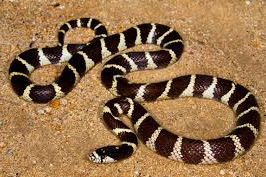top of page
Baja Reptiles

Sonoran Desert Tortoise (Gopherus morafkai)
A slow-moving herbivore found in the desert, the desert tortoise is adapted to survive extreme heat and drought by burrowing and conserving water. It's listed as a threatened species due to habitat destruction and illegal pet trade.
Western Diamondback Rattlesnake (Crotalus atrox)
This venomous snake is easily identified by the distinctive diamond pattern on its back and a rattle at the end of its tail. It is often found in dry, arid environments and uses its rattle to warn potential threats.


Red Racer (Coluber constrictor – Baja subspecies)
A fast-moving, non-venomous snake, the red racer preys on small mammals, birds, and lizards. It has a slender body with a reddish tint and is known for its agility and speed.
Baja California Alligator Lizard (Elgaria multicarinata).jpg
This species of alligator lizard is characterized by its stout body, long tail, and rough, keeled scales. It’s commonly found in rocky, scrubby areas, where it feeds on insects and smaller vertebrates.


Common Side-Blotched Lizard (Uta stansburiana).jpg
A small, active lizard with a distinctive dark blotch on its sides, the common side-blotched lizard thrives in desert and scrub environments. It is known for its territorial behavior and rapid movements.
Mojave Rattlesnake (Crotalus scutulatus).
The Mojave rattlesnake is a venomous snake that has a potent neurotoxic venom. It prefers desert habitats and is well-camouflaged, often blending into the rocky landscapes it inhabits


Desert Tortoise (Gopherus agassizii)
Found in the Sonoran Desert, this tortoise is closely related to the desert tortoise but has distinct ecological adaptations to cope with the hotter, drier conditions. It can live up to 80 years and spends much of its life burrowed underground.
Spiny-tailed Iguana (Ctenosaura pectinata)
This large, spiny-tailed lizard is known for its defensive posture, where it will puff up and display its spiny tail when threatened. It is found in both dry and scrubby habitats, where it feeds on plants and insects.


Baja California Tree Lizard (Urosaurus graciosus)
A small, agile lizard with a distinct coloration and markings, it is typically found on trees and shrubs in Baja’s arid regions. It is an excellent climber and primarily feeds on insects.
Desert Iguana (Dipsosaurus dorsalis)
The desert iguana is a medium-sized lizard adapted to life in the hot desert, often seen basking in the sun. It feeds on vegetation and plays a role in controlling plant growth in its environment.


Chuckwalla (Sauromalus ater)
A robust, stocky lizard, chuckwallas are known for their ability to wedge themselves into rocks for protection when threatened. They primarily feed on plants and are commonly found in rocky desert habitats.
California Kingsnake (Lampropeltis getula californiae)
This non-venomous snake is known for its striking black and white or black and yellow banding. It's a powerful constrictor and preys on a wide range of small animals, including other snakes.


Gila Monster (Heloderma suspectum)
One of only two venomous lizard species in the world, the Gila monster has a stout body covered in bead-like scales and a potent venom. It is a slow-moving creature that spends most of its life in burrows, feeding on eggs, small mammals, and reptiles.
Banded Rock Rattlesnake (Crotalus lepidus)
This rattlesnake species is characterized by a series of dark, contrasting bands across its body, making it well-camouflaged against rocky terrain. It is venomous but generally non-aggressive unless provoked.


Long-tailed Brush Lizard (Sceloporus graciosus)
This small lizard is known for its long, slender tail and active nature. It is typically found in brushy or rocky areas where it feeds on insects and is adept at climbing and running.
Striped Skink (Plestiodon gilberti)
With its distinct blue tail and tan body featuring dark stripes, the striped skink is a fast-moving lizard often found in desert scrub and rocky habitats. It is a ground-dweller that feeds on insects and other small invertebrates.


Coastal Garter Snake (Thamnophis elegans)
A non-venomous snake, the coastal garter snake is typically found in the vicinity of water sources, feeding on fish, amphibians, and small invertebrates. Its pattern can vary, but it usually has a striped appearance.
Western Whiptail (Cnemidophorus tigris)
A quick and active lizard, the western whiptail is easily recognized by its long tail and active foraging behavior. It is often found in desert and scrub environments and is known for its ability to chase down insects and small prey


Green Sea Turtle (Chelonia mydas)
A large, herbivorous sea turtle, the green sea turtle is often spotted along Baja California’s coastal waters. It feeds on seagrass and is known for its long migrations between feeding and nesting areas.
Loggerhead Sea Turtle (Caretta caretta)
The loggerhead sea turtle is characterized by its large head and strong jaws, which it uses to feed on hard-shelled prey like crabs and mollusks. It nests on Baja’s beaches and migrates long distances across the oceans.

bottom of page
